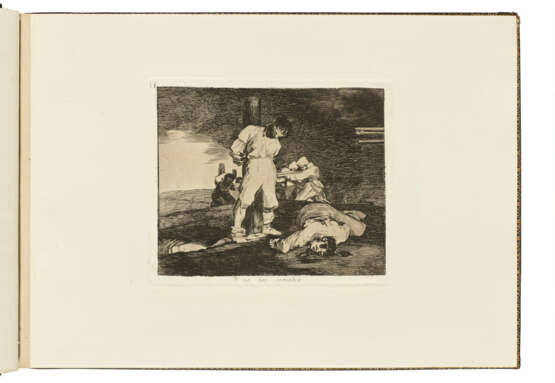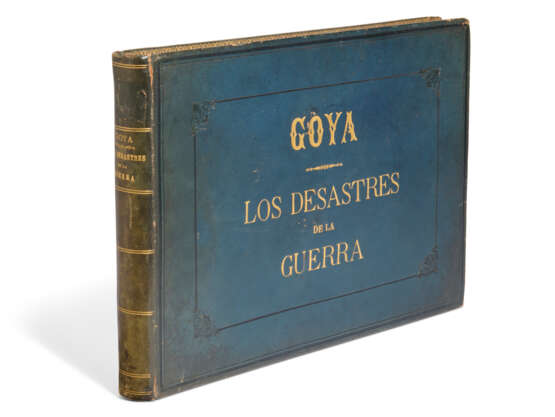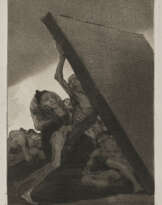ID 1449870
Lot 126 | GOYA Y LUCIENTES, Francisco de (1746-1828)
Estimate value
£ 30 000 – 50 000
Los Desastres de la Guerra. Madrid: Real Academia de Nobles Artes de San Fernando, 1863.
First edition of Goya's powerful Disasters of War. Widely regarded as a precursor to modern war reportage and photojournalism, with its unflinching realism and focus on the suffering of innocents, Los Desastres de la Guerra was created by Goya presumably over the course of ten years and in three distinct phases. The earliest plates, some of which bear the date 1810, depict scenes from the Peninsular War (1808–1814), the battles and skirmishes, the executions, rapes and mutilations, the wounded and the dead. The second group concentrates on the famine caused by the war in 1811-12, which left tens of thousands of Madrileños dead. The third and final part consists of a group of grotesques, satires and allegories reminiscent of Los Caprichos, expressing Goya’s disdain for Fernando VII’s reactionary and vengeful rule after he had regained power following Napoleon’s defeat in 1814.
It seems likely that Goya had wanted to publish the first two groups of etchings in 1814, but was prevented from doing so by Fernando’s post-war tyranny. In 1820, the revolt of Rafael del Riego and the restoration of the liberal Constitution promised liberty at last. It may have been then that Goya once again thought of publishing the series and complemented it with the caprichos enfaticos, as he called them. Yet three years later, Fernando’s absolute rule was re-established, General Riego was executed and Goya soon emigrated to France. Los Desastres de la Guerra were never published in his lifetime. When the fight for freedom was over and won, and victory had brought nothing but Fernando’s vindictive restoration, Goya certainly seemed to have lost all faith. One of the caprichos enfaticos at the end of the series (plate 69) shows a skeleton scribbling one single word as it sinks into the grave: Nada ('Nothing'). This is the second issue of the first edition, with captions corrected. Harris 121-200, 1b.
Oblong folio (240 x 345mm sheets). Lithographic title with place and date in ink manuscript, 2pp. letterpress biographical essay, the complete set of 80 etchings with burnished aquatint, drypoint and engraving on heavy wove paper, 26 with part of a J.G.O. and Palmette watermark, the rest without watermark, with margins (tiny hole in image of pl.8 due to paper flaw, title and letterpress with extremely faint spotting, otherwise the plates clean and fresh). Contemporary blue-green morocco, front cover panelled in black and blind enclosing artist's name and title lettered in gilt, gilt edges and turn-ins, white silk moire endpapers (front free endpaper loose, extremities lightly rubbed, spine faded).
| Artist: | Francisco de Goya (1746 - 1828) |
|---|---|
| Place of origin: | Europe, Spain |
| Auction house category: | Books and manuscripts, Printed books |
| Artist: | Francisco de Goya (1746 - 1828) |
|---|---|
| Place of origin: | Europe, Spain |
| Auction house category: | Books and manuscripts, Printed books |
| Address of auction |
CHRISTIE'S 8 King Street, St. James's SW1Y 6QT London United Kingdom | |
|---|---|---|
| Preview |
| |
| Phone | +44 (0)20 7839 9060 | |
| Buyer Premium | see on Website | |
| Conditions of purchase | Conditions of purchase |













